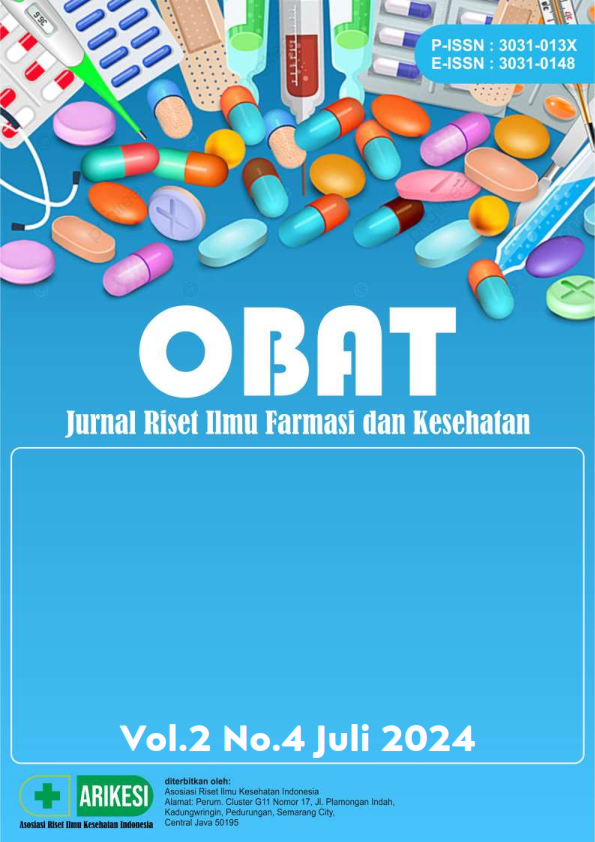Variasi Konsentrasi Fase Gerak pada Analisis Hidrokuinon dalam Sabun Pemutih dengan Metode Kromatografi Kertas
DOI:
https://doi.org/10.61132/obat.v2i4.637Keywords:
Hydroquinone, Skin Whitening Soap, Eluent, Paper ChromatographyAbstract
Hydroquinone is a compound that is often used in skin whitening beauty products. According to BPOM 2007, the use of hydroquinone at levels above 2% can cause skin disorders, namely hyperpigmentation which can lead to skin cancer. This research was conducted to qualitatively analyze the hydroquinone compound found in skin whitening soap which does not have a BPOM number. The aim of this research is to determine the presence of hydroquinone compounds contained in skin whitening soap samples and to determine the differences in Rf values resulting from the comparison of the concentrations of the mobile phase used. Qualitative analysis was carried out by calculating the Rf value of paper chromatography using a comparison of variations in mobile phase concentration, namely 50% ethanol: chloroform (1: 1) and 90% ethanol: chloroform (1: 1). The analysis results show that the standard Rf value of hydroquinone from the eluent of 50% ethanol and chloroform is 0.46, where this Rf value is the same as the Rf value from sample number 5, namely 0.46. Meanwhile, the Rf value using 90% ethanol and chloroform eluents in sample No. 5 is 0.67, which is not the same as the standard Rf value, namely 0.56. Of the whitening soap samples, 1 sample showed a positive result containing hydroquinone.
Downloads
References
Agustina Risna, Ardan Muhammad, & Masruhim Amir Muhammad. (2016). Analisis bahan kimia berbahaya pada krim pencerah wajah yang beredar di Kota Samarinda. Jurnal Universitas Mulawarman Fakultas Farmasi. Samarinda.
Alen, Y., Agresa, F. L., & Yulianda, Y. (2017). Analisis kromatografi lapis tipis (KLT) dan aktivitas anti hiper urisemia ekstrak rebung Schizostachyum brachycladum pada mencit. Jurnal Sains Farmasi dan Klinis, 3, 146–152.
Andriyani, V. B. (2011). Identifikasi asam retinoat dalam krim pemutih wajah secara KLT. Tugas Akhir. Medan: Universitas Sumatera Utara.
Astuti Wuri Dian, Prasetya Rayi Hieronimus, & Irsalina Dina. (2016). Identifikasi hidrokuinon pada krim pemutih wajah yang dijual di minimarket wilayah Minomartini, Yogyakarta. Jurnal.
Badan POM RI. (2007). Kenalilah kosmetik Anda, sebelum menggunakan. POM, 7(4), 1–5. Jakarta.
Badan POM RI. (2008). Bahan berbahaya dalam kosmetik. POM, 2(8), 1–6. Jakarta.
Badan POM RI. (2011). Peraturan Kepala Badan Pengawas Obat dan Makanan Republik Indonesia Nomor HK.03.1.23.08.07331 tahun 2011 tentang kosmetik. Jakarta.
David. (2010). Pengantar kromatografi. Bandung: Institut Teknologi Bandung Press.
Day, R. A., & Underwood, A. L. (2002). Analisis kimia kuantitatif (6th ed.). Jakarta: Erlangga.
Dwikarya, M. (2002). Merawat kulit wajah. Jakarta: PT. Elex Media Komputindo.
Khopkar, S. M. (2008). Konsep dasar kimia analitik (A. Saptorahardjo & A. Nurhadi, Trans.). Jakarta: Universitas Indonesia.
Ningsih Utami Ayu. (2009). Identifikasi hidrokuinon dalam krim pemutih selebritis night cream dengan metode kromatografi lapis tipis. Jurnal. Medan: Universitas Sumatera Utara.
Nurfitriani Susan, Hadi Soebroto, & Budiman Senadi. (2015). Analisis kualitatif dan kuantitatif zat hidrokuinon pada kosmetik krim pemutih yang beredar di Kota Bandung. Jurnal (ISBN: 978-602-73060-1-1). Bandung: Universitas Al-Ghifari.
Olumide, Y. M., Akinkugbe, A. O., Altraide, D., Mohammed, T., Ahamefule, N., Ayanlowo, S. C., & Onyekonwu, N. E. (2008). Complications of chronic use of skin lightening cosmetics. International Journal of Dermatology, 47, 344–353.
Sarjoni Basri. (2005). Kamus kimia. Jakarta: PT. Rineka Cipta.
Soebagio. (2003). Kimia analitik II. Jakarta: IMSTEP.
Downloads
Published
How to Cite
Issue
Section
License
Copyright (c) 2024 OBAT: Jurnal Riset Ilmu Farmasi dan Kesehatan

This work is licensed under a Creative Commons Attribution-ShareAlike 4.0 International License.





